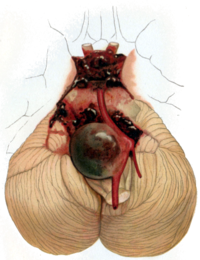
Photo from wikipedia
Introduction Elective aneurysm treatment in elderly patients may be associated with a higher risk of complications due to frailty, atherosclerosis, and tortuosity. Because of these concerns, observation is often favored.… Click to show full abstract
Introduction Elective aneurysm treatment in elderly patients may be associated with a higher risk of complications due to frailty, atherosclerosis, and tortuosity. Because of these concerns, observation is often favored. However, with a growing elderly population, many of whom are in good health, endovascular management of elective aneurysms could be considered. The aim of this study is to analyze clinical outcomes in patients older than 70 years with unruptured cerebral aneurysms treated electively. Methodology All patients over 70 years of age who were treated electively for unruptured cerebral aneurysms between Jan 2017-Feb 2019 at Westchester Medical Center were included in the study. A retrospective chart review was performed. Demographics, presentation, aneurysm location, clinical complications, and modified Rankin score (mRS) at 30 days were noted. Good outcomes were defined as mRS<2 at 30-days or discharge to home and bad outcomes were defined as mRS>2 or rehab placement. To compare pre-existing comorbidities, the Charlston Comorbidity Index (CCI) was used. Results A total of 22 patients were included with a mean age of 76.8 years (range 71–86 years). The male:female ratio was 1:6. 78% of the procedures involved flow diversion using the Pipeline Flex device; the remaining 22% involved coil embolization. There were no neurological complications in our series. Groin complications were seen in 2 patients. The mean CCI for the entire group was 6 and for those with complications was 7. Good outcomes were seen in 95.4% (21/22) of the patients included in this study. Conclusion Contrary to popular assumption, good outcomes were seen in more than 95% of patients above 70 years of age who undergo elective treatment of unruptured cerebral aneurysms. The rate of neurological complications was 0% in our series. The 2 groin complications noted in this series may be associated with atherosclerotic vasculature and use of dual antiplatelet agents for flow diversion. Given the overall safety and the probability of good outcomes, these findings suggest that patients above 70 years with high-risk unruptured aneurysms should not be denied elective aneurysmal treatment. Disclosures G. Kaur: None. J. Cooper: None. L. Melathe: None. F. Al-Mufti: None. C. Gandhi: None. J. Santarelli: None.
Journal Title: Journal of NeuroInterventional Surgery
Year Published: 2019
Link to full text (if available)
Share on Social Media: Sign Up to like & get
recommendations!